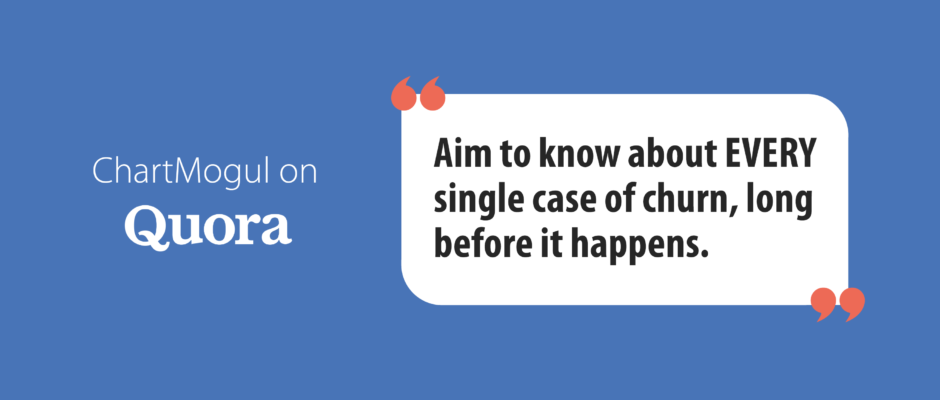View the original question here on Quora:
Happy Churn is an interesting one, and is in some ways a double-edged sword. Here’s our definition from The Ultimate SaaS Churn Rate Cheat Sheet:
Happy churn: A subset of pro-active churn, happy churners are common in certain types of businesses. These are customers who finished using your product for their campaign (or similar short term use case), so cancel with a positive experience. One way to identify happy churners is to look at what % of cancelled accounts reactivate at a later date – or to simply ask your customers why they cancelled.
On the one hand, it’s great that the customer has had a good experience with your product, and received some value from it. You’re clearly doing a good job at acquiring them, onboarding them, and guiding them to the point of value.
Conversely, the fact that they no longer need your service suggests some flaws with the product on a more fundamental level. They don’t need it any more. And when all is said and done, churn is still… well, churn. They’re no longer paying you.
How to identify Happy Churn
- Interview customers BEFORE they cancel, and know ahead of time if they’re continuing to see value from the product. Aim to know about every single case of churn by the time it happens. In turn, you’ll also know exactly why it happens.
- Add a tiny survey on the cancel page, so you can catch a reason for those customers whom you haven’t spoken to.
- Look at your reactivation MRR (see below).
What causes Happy Churn?
There are a few common product traits that lend themselves to a high rate of Happy Churn:
Seasonal products
These is more common than you’d think. If the very nature of your business is isolated to a specific part of the year or a point in a business’s lifecycle, you can expect that people only need your product at this time.
Examples:
- A SaaS tool for managing your tax returns (only useful when it’s tax return time).
- HRM tool for managing hiring (only useful when you’re actually hiring).
- An events tool for handling event publicity & ticketing (only useful when you’re putting on an event).
‘One-shot’ products
This is where the product really only needs to be used once to receive all of its value. After that, you just don’t have a need for it any more. In this case, it’s not really a suitable fit for a SaaS model in the first place.
Examples:
- A tool for finding out your credit score. There’s no predictable pattern for when you’d need this after the first use (therefore it’s not even seasonal).
- A tool for managing and distributing wedding photos. Most people don’t plan to get married more than once in their life…
- A tool for finding and leasing enterprise office space.
A narrow value band
If your product caters to a highly specific target customer and use case combination, you could find that customers, once signed up, may fall outside of that narrow value band very easily. When this happens, they’ll find that they received value from your product but it’s just not really relevant to them any more. To combat this, you’d need to change your product, designing for a slightly wider set of use cases.
Example:
A weight-loss/health app which doesn’t offer any more value after you’ve lost weight. (Hint: In this case you could quite easily expand the use case and target audience by positioning it more as a general health & fitness app.)
The flip side: High Reactivation MRR
One characteristic that goes hand-in-hand with high Happy Churn is increased Reactivation MRR. This is especially prominent with seasonal businesses, when the customer comes back (reactivates) the next time they need your product. Make sure you identify this correctly in your analytics – you don’t want to attribute reactivation MRR to new business MRR.
So how do you deal with Happy Churn?
I interviewed Nikos, CEO of Workable (a SaaS HRM solution) about exactly this.
As an HRM solution often does, they see a large proportion of Happy Churn and Reactivation MRR. When asked “so how do you tackle that?”, Nikos’ take on it was that it’s not such a huge problem when you’re growing so quickly. Having said that, they are looking at ways to enhance the product to be less seasonal in nature.
You can listen to the entire interview with Nikos here:
If significantly changing your product is not something you’re able to do right now, there are a number of things you can do to make sure your Happy Churn doesn’t turn into ‘Churn Churn’:
- Keep talking. Don’t close down dialog with customers who cancel. Make sure it’s YOUR solution they think of when they need it again.
- Ask what would make them stick around. Perhaps having a very cheap plan with some ongoing value is better than having them cancel altogether (you’re then just dealing with downgrade MRR).
- Move to an annual plan only. I’ve seen this as a common strategy against the problems with seasonal SaaS products. Just make them buy a year up-front – this way, there’s really no option to churn each time they don’t need your product for a while.
Don’t forget to go and download our Churn Rate Cheat Sheet, which has a wealth of information on classifying churn, as well as other handy references.
